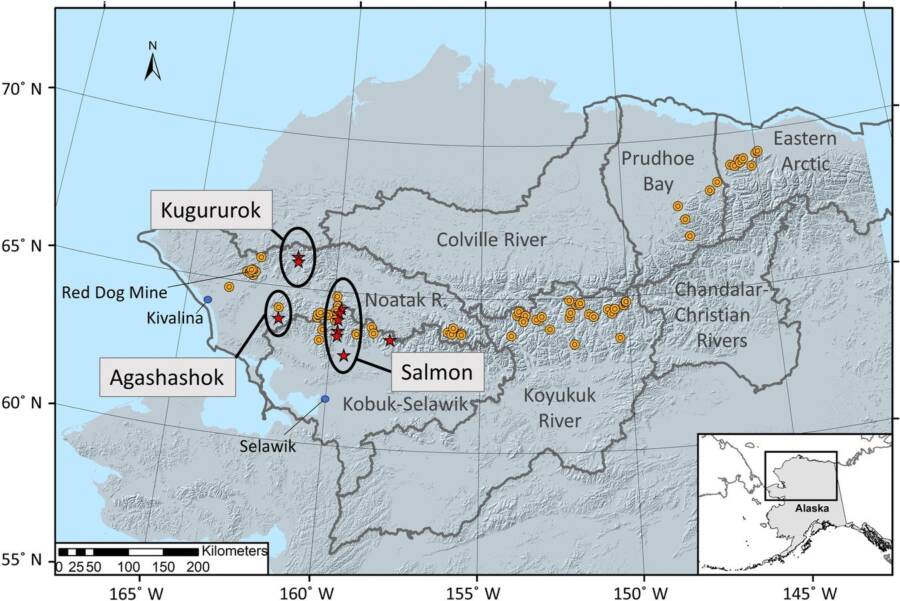At least 75 rivers in Alaska have turned orange so far as permafrost melts and releases minerals like iron into the water.

Josh Koch/U.S. Geological SurveyWater runs orange in this tributary of the Kugururok River in Alaska.
Alaska is known for its picturesque nature, its majestic peaks and stunning vistas. But a number of its normally clear waterways have suddenly turned orange — and scientists believe climate change is to blame.
They’re concerned that the orange rivers could have a catastrophic impact on wildlife and local populations. And more and more rivers seem to be changing colors as Alaska’s permafrost continues to melt.
Why Rivers In Alaska Are Turning Orange
According to a collaborative study from the University of California, Davis, the U.S. Geological Survey, and the National Park Service, at least 75 rivers in Alaska have turned orange since 2017. So what is going on?
As the researchers explain in their study, the phenomenon can be traced back to the thawing of permafrost. The soil in Alaska contains metals like zinc, copper, cadmium, iron, lead, and arsenic. As the climate warms and the permafrost rapidly melts, these metals have made their way into Alaska’s waterways.

Ken Hill/National Park ServiceWaterways that have turned orange are marked on this map with orange circles.
Metals like iron react with oxygen in the water, which turns rivers and streams orange as they “rust.” And the number of impacted waterways seems to be increasing. After first recording the phenomenon between 2017 and 2018, researchers have documented 75 waterways in varying shades of orange.
“Orange streams have been observed across much of northern Alaska, spanning traditional territories of the Alaska Native peoples in the Noatak, Kobuk, and Koyukuk River basins; public lands; designated wilderness; and within watersheds of several National Wild and Scenic Rivers, including the Alatna, John, Koyukuk, Tinayguk, and Salmon rivers,” the study explained.
In their study, researchers call this troubling trend an “emergent threat” and warn that “orange streams have lower pH, higher turbidity, and higher sulfate, iron, and trace metal concentrations.”
So what might it mean for humans and animals in Alaska?
How Orange Rivers Could Impact Wildlife And Humans In Alaska
Alaska’s orange rivers could have a catastrophic impact up and down the food chain, impacting everything from fish to sources of drinking water.

Ken Hill/National Park ServiceAlaska’s Kutuk River is one of dozens of waterways in the state that have started to take on an orange hue.
First of all, Alaska is home to a number of fish “which are critical for subsistence, sport, and commercial fisheries,” according to the study. But the influx of iron and other toxic metals in Alaskan waterways “may both degrade water quality and reduce habitat.”
At a tributary of the Akillik River, for example, researchers documented “the complete loss of fish species, juvenile Dolly Varden (Salvelinus malma) and Slimy Sculpin (Cottus cognatus).” They noted that an accumulation of metals like iron in fish gills, liver, and muscle tissue “is known to structurally impair gills, damage DNA, and decrease growth and survival.”
The orange rivers may also negatively impact Alaska’s human population.
“Beyond the effects on subsistence resources, the metals transported downstream from headwater streams to higher-order rivers may impact drinking water supplies to rural communities,” the study explained.
Now, the researchers are calling attention to the problem to better determine how to respond to it.
“Our initial findings indicate that orange streams are an indicator of impaired water quality and are associated with declines in stream biodiversity and habitat degradation,” the researchers concluded in their study. “Understanding the magnitude, spatial extent, persistence, and timing of stream degradation may inform management responses by federal and state agencies and adaptation by rural communities and subsistence users.”
After reading about how rivers in Alaska are turning orange, see how climate change is revealing more and more bodies of climbers who perished on Mount Everest. Or, see how actor Morgan Freeman decided to open a bee sanctuary to protect the species after their numbers started to plummet.





